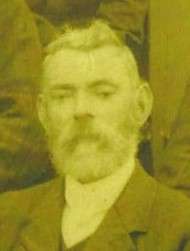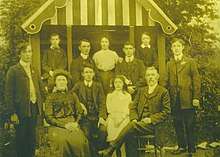Timothy Crowley
Timothy Crowley (31 July 1847[1] – 19 October 1921[2]) was an Irish revolutionary who was a member of the Irish Republican Brotherhood (IRB)[3] and later the Irish Republican Army (IRA)[4]. He fought in the Fenian Rising of 1867, and was the secretary of the IRB in Hospital, County Limerick[3]. He was the patriarch of the prominent Irish republican Crowley family of Ballylanders, and the father of the longest hunger strikers in history, Peter William Crowley and John Crowley[5][6], and the Fianna Fáil Politician Tadhg Crowley.
Timothy Crowley | |
|---|---|
 | |
| Born | 31 August 1847 Knockainey, County Limerick, Ireland |
| Died | 19 October 1921 (aged 74) Glin, County Limerick, Ireland |
| Spouse(s) | Ellen Ryan (m. 1887) |
| Children | Tadhg Crowley, John Crowley, Peter William Crowley, 6 others |
Early life
He was baptised on 31 July 1847 to James Crowley and Bridget Dwyer of Elton, in the parish of Knockainey, County Limerick. His parents had been married two years prior, and his sponsors were Thomas Dwyer and his grandmother Bridget Dwyer (née Ashe)[1]. He was the second eldest of eight siblings and grew up on an acre of land on the banks of the river Morningstar, his father being a herdsman.[7]
Fenian activities
Crowley joined the Irish Republican Brotherhood (IRB) prior to 1867 and took part in the Fenian Rising of 1867. He also was the secretary of the IRB in Hospital, County Limerick. He would never lose his Irish nationalist beliefs, carrying them down to his children in the future.[3]
Crowley Drapery and Marriage
Crowley had founded the Crowley Drapery in Ballylanders, which still exists today, by the time of his marriage on 19 February 1887 to Ellen Ryan of Killeen. He served as the village's post master and ran the telegram, however these duties would be removed from him three decades in the future as the British found out he had been reading the messages to pass on information to the IRB. People came from far and wide to buy clothes for all occasions from the drapery, and his wife Ellen would often travel to London to purchase the latest fashions.
Timothy Crowley and Ellen Ryan had nine children together: James Joseph Crowley (1889-1894), Tadhg Crowley (1890-1969), John Crowley (1891-1942), Patrick Joseph Andrew Crowley (1893-1963), Mark Joseph Crowley (1894-1957), James Michael Crowley (1896-1944), Michael Thomas Crowley (1898-1952), Peter William Crowley (1900-1963) and Bridget Mary Crowley (1902-1983).[8]

Irish War of Independence
By the start of the Irish War of Independence, Crowley and all of his sons were in the Irish Republican Brotherhood, the Irish Volunteers, and the Irish Republican Army, with the exception of his son Patrick, who had become a priest and gone to serve in Montana in the United States. His daughter Bridget was in Cumann na mBan. In 1916, the Crowleys were advised to resign from these organisations publicly, which they did, though they remained active in them. It was around this time that Crowley lost the position of village postmaster as the British feared that they were reading their top secret letters and telegrams, which they were.
In July 1920, Crowley , at that point 72, ambushed a patrol of Royal Irish Constabulary members with his sons and took them prisoner. It was later that month that the British army returned and engaged in a shootout with the Crowleys at 3 am at their drapery. This firefight ended with the drapery being set on fire and the Crowleys arrested. The British later came back and blew up the drapery, reducing it to smoldering ruins and leaving around one million euros worth of damage in today's money. Crowley was not brought to trial due to his advanced age, though there was much discussion among the British government over whether to reimburse Crowley's money after his drapery was destroyed. Eventually it was decided not to, with British intelligence saying that, "despite his advanced age, he is the most dangerous man in the Galtees, and any funds given to him would be used without a doubt in the murder of the Crown's forces". [3][4]
While Crowley avoided imprisonment, his sons did not. Tadhg and Michael were imprisoned in England, while John and Peter ended up in Cork County Gaol, where they undertook a hunger strike of 94 days along with some others. This was the longest hunger strike in history, lasting from 11 August to 12 November 1920, and was at the same time as Terence MacSwiney's hunger strike in which he died.[5]
Death
He did not live for much longer after his sons' imprisonment, passing away from sudden heart failure on 19 October 1921 at the age of 74 in the home of his sister-in-law's husband, John Culhane, whom they were staying with in Glin after the destruction of the Crowley Drapery.[8] He is buried in Knockainey along with his wife, and sons John and James. The Crowley Drapery has since been rebuilt and still exists today.
References
- "Timothy Crowley Baptism".
- "Irish Genealogy". civilrecords.irishgenealogy.ie. Retrieved 2019-11-09.
- Witness Statement of Tadhg Crowley for the Bureau of Military History, 1950
- Ireland, Courts Martial Files, 1916–1922
- Tuesday; August 13; Pm, 2019-12:26 (2019-08-13). "Death of MacSwiney had enormous significance as prisoners hunger strike drew global coverage". www.irishexaminer.com. Retrieved 2019-11-09.CS1 maint: numeric names: authors list (link)
- Russell, Alan (1987). The Guinness Book of Records 1988. Jim Pattison. ISBN 978-0-85112-868-9.
- Griffith's Valuation, 1851
- "Irish Civil Records".